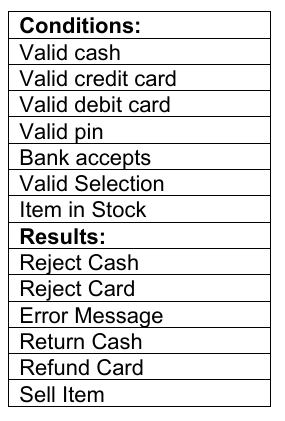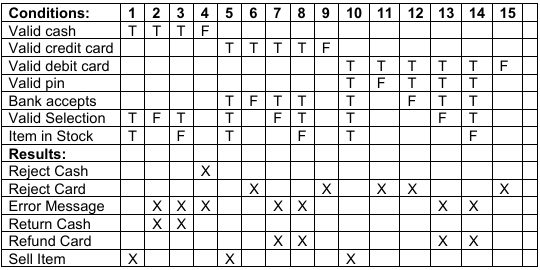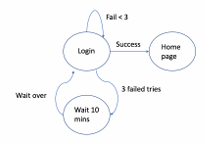QA Testing Sample Test 1
1/40
There's no tags or description
Looks like no tags are added yet.
Name | Mastery | Learn | Test | Matching | Spaced |
|---|
No study sessions yet.
41 Terms
Identify typical test objective.
When the tester verifies the test basis while designing tests early in the lifecycle, which test objective is being achieved?
Evaluating work products.
This is a bit tricky because you are very likely to find defects while doing this analysis and this may lead to either gaining or destroying confidence and needing to supply information to the decision makers. What is occurring here is an evaluation of the work product, in this case the requirements.
Recall the advantages of the whole team approach.
In some Agile teams, people are encouraged to use their skills to help the team, regardless of their role. This could mean that testers help the developers write code and developers help testers test.
What is this approach called?
Whole Team
This is an example of the Whole Team approach where the team members leverage their skills, regardless of roles, to accomplish the goals of the team.
Distinguish between root cause, error, defect, and failure.
Which of the following is a correct statement?
A developer makes a mistake which causes a defect that may be seen as a failure during dynamic testing.
The developer makes a mistake/error which causes a defect/fault/bug which may cause a failure when the code is dynamically tested or executed.
Explain the seven testing principles. Why is it important to avoid the principle of tests wearing out?
Running the same tests repeatedly will reduce the chance of finding new failures. As tests are run repeatedly, the tests become less effective.
Summarize the different test activities and tasks.
When following a standard test process, when should the test control activity take place?
During the planning activities, during implementation and execution activities, and during monitoring activities.
Control occurs throughout the project to ensure that it is staying on track based on the plan and to take any corrective steps that may be necessary. The monitoring information is used to determine if control actions are needed.
Summarize the different test activities and tasks.
Which of the following is the activity that compares the planned test progress to the actual test progress?
Test monitoring.
Test monitoring involves the on-going comparison of actual progress against the test plan.
Explain the impact of context on the test process.
If you are working on a project that is constrained by time and budget, which is pressuring testing to be done quickly.
How should the test approach be adjusted?
Use techniques such as exploratory and checklist testing to spend less time on test case development.
These techniques will help adjust to the project context where there is pressure to test quickly. These are lightweight approaches that require less time preparing documentation and allow test execution to start sooner.
Distinguish the benefits and drawbacks of independence of testing
Developers are not objective about their own code.
This is the biggest problem because developers have biases toward the accuracy and implementation of their own code. Testers and developers think differently and testers can be more objective as they are not invested in the code.
Recall good testing practices that apply to all software development lifecycles.
Which of the following is an example of a good testing practice?
Testers should review requirements documents as soon as a readable draft is available.
Recall the examples of test-first approaches to development.
When coding is directed by the test cases, what development approach is being used?
TDD. Test-Driven Development
Distinguish the different test levels.
During which level(s) of testing should non-functional tests be executed?
Unit, integration, system and acceptance only.
Non-functional tests can and should be executed at all levels of testing.
Summarize maintenance testing and its triggers.
When a system is targeted for decommissioning, what type of maintenance testing may be required?
Data migration testing.
Data migration to another system or data migration to an archival system may be needed.
Explain the impact of the chosen software development lifecycle on testing. In an iterative lifecycle model, which of the following is an accurate statement about testing activities?
For every development activity, there should be a corresponding testing activity. For any lifecycle model, this is a correct statement.
Explain the shift-left approach.
In what way is CI/CD an example of the concept of shift-left?
CI/CD requires continuous testing, including test automation, to be implemented for the entire pipeline.
This starts testing as early as possible and shifts it to the left in the timeline.
Recall which responsibilities are assigned to the principal roles when performing reviews.
In a formal review, which role is normally responsible for documenting all the open issues?
The scribe.
What is a scribe?
The scribe is normally responsible for documenting all issues, problems and open points. The author may take notes as well, but that is not their primary role.
Identify the benefits of early and frequent stakeholder feedback.
What is the primary reason to get early and frequent feedback from stakeholders regarding a product being developed?
To ensure that their vision for the product will be realized.
By getting their feedback, the team can ensure that what they are building is what the stakeholders want.
Explain the value of static testing.
Which of the following is a benefit of static analysis?
Defects can be identified that might not be caught by dynamic testing.
Static analysis with a static analyzer can be used to find defects such as uninitialized variables that could be difficult to catch with dynamic testing.
Summarize the activities of the review process.
For a formal review, at what point in the process are the exit criteria defined?
Planning.
The entry and exit criteria should be defined during the planning step in the review process. These should be evaluated at each step to ensure the product is ready for the next step in the process.
Distinguish black-box, white-box, and experience-based test techniques.
Which of the following test techniques uses the requirements specifications as a test basis?
Black-box.
Black-box testing is based off the requirements documents.
Explain branch testing.
If you are testing a module of code, how do you determine the level of branch coverage you have achieved?
By taking the number of branches you have tested and dividing that by the total number of branches in the module.
Branch coverage looks at the number of branches tested versus the number of branches in the code under test.
Explain branch testing.
If you have a section of code that has one simple IF statement, how many tests will be needed to achieve 100% branch coverage?
2
A simple IF statement will be composed of If ... then ... else.... end if. There are two branch outcomes, one for the result of the If being true and one for it being false. Since 100% branch coverage requires at least one test case for each branch outcome, two tests are needed.
Explain exploratory testing.
Which of the following is a good reason to use experience-based testing?
You can find defects that might be missed by more formal techniques.
Experience-based testing is often used to fill in the gaps left by the more formal testing techniques.
Explain error guessing.
What is error guessing?
A testing technique used to guess where a developer is likely to have made a mistake.
Error guessing is a technique used to anticipate where developers are likely to make errors and to create tests to cover those areas.
Explain how to write user stories in collaboration with developers and business representatives.
When using the 3 C’s technique for user story development, what is the work product that is created for the Confirmation aspect?
Acceptance Criteria.
The confirmation aspect of the 3 C’s is the acceptance criteria.
Use equivalence partitioning to derive test cases.
You are testing a machine that scores exam papers and assigns grades. Based on the score achieved the grades are as follows: 1-49 = F, 50-59 = D-, 60-69 = D, 70-79 = C, 80-89 = B, 90-100=A
If you apply equivalence partitioning, how many test cases will you need to achieve minimum test coverage?
8.
You need a test for the invalid too low (0 or less), one for each valid partition, and one for invalid too high (>100). It may not allow you to enter a value > 100, but it should be tested to make sure it provides a proper error.
Use boundary value analysis to derive test cases.
You are testing a thermostat for a heating/air conditioning system. You have been given the following requirements:
• When the temperature is below 70 degrees, turn on the heating system
• When the temperature is above 75 degrees, turn on the air conditioning system
• When the temperature is between 70 and 75 degrees, inclusive, turn on fan only
Which of the following is the minimum set of test temperature values to achieve 100% two-value boundary value analysis coverage?
69, 70, 75, 76
For the heating system, the values to test are 69, 70
For the air conditioning system, the values are 75, 76
For the fan only, the values are 69, 70, 75, 76
<-- 69 | 70 – 75 | 76 —>
The proper test set combines all these values, 69, 70, 75, 76
Use decision table testing to derive test cases.
You have been given the following conditions and results from those condition combinations.
Given this information, using the decision table technique, what is the minimum number of test cases you would need to test these conditions

15

Use state transition testing to derive test cases.
You have been given the following requirement:
A user must log in to the system with a valid username and password. If they fail to enter the correct combination three times, they will receive an error and will have to wait 10 minutes before trying again. The test terminates when the user successfully logs in.
How many test cases are needed to provide 100% state transition coverage?
1
Per the diagram below, only one test is needed: Login, Fail, Fail, Fail =3, Wait, Login, Home. If you were required to exit after the Wait, a second test would be required but the question doesn’t indicate that an exit is required.

Use acceptance test-driven development (ATDD) to derive test cases. You are creating test cases for the following story, applying the ATDD approach:
As a hotel owner I want to reserve all the rooms on a floor before moving to the next floor So I can maximize the efficiency of the housekeeping staff
You have decided to apply equivalence partitioning to this requirement and have identified the following partitions for the occupancy of a floor:
0 | 1 - floor full | overbooked
You also want to be sure that the software is usable by the staff and that it performs quickly in determining which floors have availability.
Given this information, what should be the priority order for the tests you will design?
0, 1-floor full, overbooked, usability, performance.
This tests the valid scenarios first, then invalid (overbooked), then the non-functional tests.
Recall metrics used for testing.
A metric that tracks the number of test cases passed is gathered during which activity in the test process?
Execution.
Test execution metrics are gathered during the Test Execution activity. These metrics are used in reporting.
Exemplify the purpose and content of a test plan.
You are working in a team of testers who are all writing test cases. You have noticed that there is a significant inconsistency with the length and amount of detail in the different test cases. Where should the criteria for test case writing be documented?
The test plan.
The level of detail and structure for the test documentation should be included in the test plan as part of the criteria for the performance of testing activities.
Summarize the testing quadrants and their relationships with test levels and test types.
Unit tests belong in which testing quadrant?
Q1Unit, or component, tests belong to quadrant 1.
Distinguish between project risks and product risks. Which of the following is a project risk?
A problem with the development manager which is resulting in his rejecting all defect reports
Summarize the purposes, content, and audiences for test reports.
Which of the following variances should be explained in the Test Summary Report?
The variances between what was planned for testing and what was actually tested.
The variances or deviations between the test plan and the testing that was actually done must be explained in the test summary report.
Summarize how configuration management supports testing.
If the developers are releasing code for testing that is not version controlled, what process is missing?
Configuration management.
Configuration management is missing if the code is not being properly versioned and tracked.
Use estimation techniques to calculate the required test effort.
Your team is using Planning Poker to estimate the effort for a story.

Although three votes were taken to reach consensus, how many story points should be allocated to the story?
5 because that was the consensus. Voting should continue until consensus is reached and that number should be used to assign the points to the story.
Apply test case prioritization.
You have been given the following set of test cases to run. You have been instructed to run them in order by risk and to accomplish the testing as quickly as possible to provide feedback to the developers as soon as possible.
Given this information, what is the best order in which to run these tests?

2, 4, 5, 6, 1, 3
addresses the highest risk and fastest tests first. It runs a fast medium test before a slow and more dependent high-risk test because this will give feedback to the developers more quickly.
Prepare a defect report. You have been testing software that will be used to track credit card purchases. You have found a defect that causes the system to crash, but only if a person has made and voided 10 purchases in a row. What is the proper priority and severity rating for this defect?
Priority low, severity high. This is not likely to happen, so the urgency to fix it is low but it does crash the system so the impact to the system is high so the severity should be high.
Explain how different types of test tools support testing. Which of the following is an example of a tool that supports static testing?
A tool that assists with tracking the results of reviews. Reviews are a form of static testing and a tool that supports reviews is an example of a tool that supports static testing.
Recall the benefits and risks of test automation. Which of the following is a benefit of test automation?
Test execution is faster. Test execution should be faster with automation than with manual testing, once the test cases have been developed.